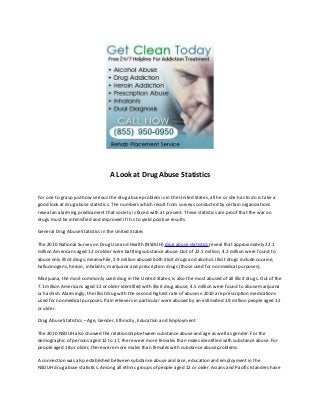A look at drug abuse statistics
•Download as DOC, PDF•
0 likes•422 views
http://huntingtonbeach.treatmentcenterpage.com/ Call Now to : (855) YES-REHAB
Report
Share
Report
Share

Recommended
More Related Content
Featured
Featured (20)
Product Design Trends in 2024 | Teenage Engineerings

Product Design Trends in 2024 | Teenage Engineerings
How Race, Age and Gender Shape Attitudes Towards Mental Health

How Race, Age and Gender Shape Attitudes Towards Mental Health
AI Trends in Creative Operations 2024 by Artwork Flow.pdf

AI Trends in Creative Operations 2024 by Artwork Flow.pdf
Content Methodology: A Best Practices Report (Webinar)

Content Methodology: A Best Practices Report (Webinar)
How to Prepare For a Successful Job Search for 2024

How to Prepare For a Successful Job Search for 2024
Social Media Marketing Trends 2024 // The Global Indie Insights

Social Media Marketing Trends 2024 // The Global Indie Insights
Trends In Paid Search: Navigating The Digital Landscape In 2024

Trends In Paid Search: Navigating The Digital Landscape In 2024
5 Public speaking tips from TED - Visualized summary

5 Public speaking tips from TED - Visualized summary
Google's Just Not That Into You: Understanding Core Updates & Search Intent

Google's Just Not That Into You: Understanding Core Updates & Search Intent
The six step guide to practical project management

The six step guide to practical project management
Beginners Guide to TikTok for Search - Rachel Pearson - We are Tilt __ Bright...

Beginners Guide to TikTok for Search - Rachel Pearson - We are Tilt __ Bright...
A look at drug abuse statistics
- 1. A Look at Drug Abuse Statistics For one to grasp just how serious the drug abuse problem is in the United States, all he or she has to do is take a good look at drug abuse statistics. The numbers which result from surveys conducted by certain organizations reveal an alarming predicament that society is faced with at present. These statistics are proof that the war on drugs must be intensified and improved if it is to yield positive results. General Drug Abuse Statistics in the United States The 2010 National Survey on Drug Use and Health (NSDUH) drug abuse statistics reveal that approximately 22.1 million Americans aged 12 or older were battling substance abuse. Out of 22.1 million, 4.2 million were found to abuse only illicit drugs; meanwhile, 2.9 million abused both illicit drugs and alcohol. Illicit drugs include cocaine, hallucinogens, heroin, inhalants, marijuana and prescription drugs (those used for nonmedical purposes). Marijuana, the most commonly used drug in the United States, is also the most abused of all illicit drugs. Out of the 7.1 million Americans aged 12 or older identified with illicit drug abuse, 4.5 million were found to abuse marijuana or hashish. Alarmingly, the illicit drug with the second highest rate of abuse in 2010 are prescription medications used for nonmedical purposes. Pain relievers in particular were abused by an estimated 1.9 million people aged 12 or older. Drug Abuse Statistics – Age, Gender, Ethnicity, Education and Employment The 2010 NSDUH also showed the relationship between substance abuse and age as well as gender. For the demographic of persons aged 12 to 17, there were more females than males identified with substance abuse. For people aged 18 or older, there were more males than females with substance abuse problems. A connection was also established between substance abuse and race, education and employment in the NSDUH drug abuse statistics. Among all ethnic groups of people aged 12 or older, Asians and Pacific Islanders have
- 2. the lowest rate of substance abuse (4.1 and 5.6 percent, respectively). It was found that rates of substance abuse were lower for those who graduated from college (7.3 percent) compared to those who just graduated from high school (8.3 percent) or those who did not graduate from high school (10.2 percent). Drug Abuse Statistics – Treatment Unfortunately, not everyone gets treatment for alcohol or drug abuse, even if such treatment is necessary. Drug abuse statistics show that though 23.1 million Americans aged 12 or older required treatment for drug or alcohol abuse issues, only 2.6 million received it. This means that 20.5 million people did not get the treatment they needed. Call toll free for immediate help : (855) 937-7342 abuse89249drug72948